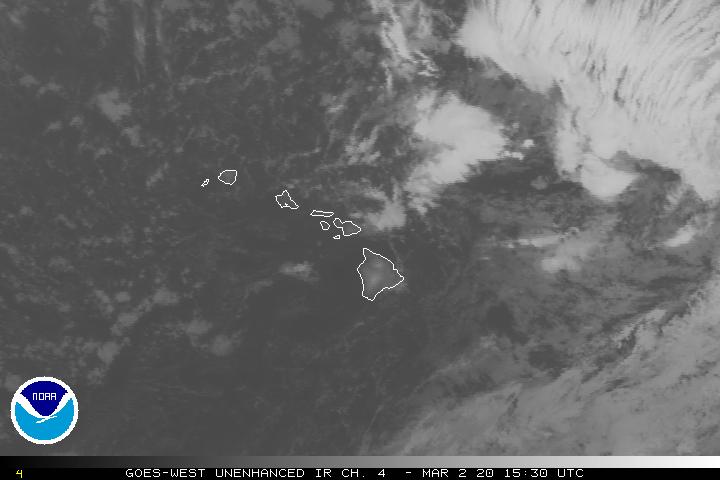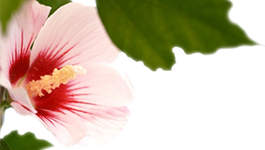Air Temperatures – The following maximum temperatures (F) were recorded across the state of Hawaii Tuesday…along with the minimums Tuesday:
82 – 63 Lihue, Kauai
84 – 71 Honolulu, Oahu
79 – 67 Molokai AP
85 – 70 Kahului AP, Maui
83 – 71 Kailua Kona
87 – 64 Hilo AP, Hawaii
Here are the latest 24-hour precipitation totals (inches) for each of the islands, as of Tuesday evening:
0.10 Kokee, Kauai
0.23 Palehua, Oahu
0.21 Molokai
0.00 Lanai
0.00 Kahoolawe
0.05 Puu Kukui, Maui
0.05 Kahua Ranch, Big Island
The following numbers represent the strongest wind gusts (mph)…as of Tuesday evening:
28 Lihue, Kauai – N
24 Kalaeloa, Oahu – NE
23 Molokai – NE
24 Lanai – NW
27 Kahaloowe – NNW
20 Maalaea Bay, Maui – NNE
18 South Point, Big Island – NNE
Hawaii’s Mountains – Here’s a link to the live web cam on the summit of near 13,800 foot Mauna Kea on the Big Island of Hawaii. This web cam is available during the daylight hours here in the islands…and when there’s a big moon shining down during the night at times. Plus, during the nights you will be able to see stars, and the sunrise and sunset too…depending upon weather conditions.
Aloha Paragraphs

A deep storm is spinning to our north…pushing a weak cold front
through the islands from the northwest

Northeast to southwest frontal cloud band over Hawaii…with
lots of high cirrus clouds to our south

Clear to partly cloudy…some cloudy areas

Some passing showers…mostly light
looping radar image
High Surf Warning…a very large northwest swell will
cause hazardous surf conditions today
High Surf Advisory…Olomana, Kona, north and east Kohala
Small Craft Advisory…for a large northwest swell causing
elevated seas
Wind Advisory…for 40-50 mph winds with gusts to 55
atop the Big Island summits
~~~ Hawaii Weather Narrative ~~~
Cooler breezes from the north tonight…then light trade winds Wednesday for several days. Here’s the latest weather map, showing the Hawaiian Islands, and the rest of the North Pacific Ocean. We find high pressure systems far northeast and northwest. At the same time, there’s a weak ridge of high pressure just south of the islands. In addition, there’s numerous low pressure systems to the northeast through northwest of Hawaii. As the current cold front stalls near or over the Big Island tonight…we’ll find slightly chilly northerly breezes briefly in the wake of the front. It looks likely that we’ll find a period of trade winds Wednesday into Friday. Yet another cold front moves towards, and perhaps down into the state Friday night into Saturday, bringing back more light winds.
Here’s a wind profile…of the offshore waters around the islands – with a closer view
Here’s the Hawaiian Islands Sulfate Aerosol…animated graphic – showing vog forecast
A weak cold front is moving through the state…although the associated rainfall wasn’t impressive. Northerly winds in the wake of this weak front will bring cool conditions, and potentially a few more showers into the middle of the week. Looking further ahead, yet another cold front will approach Kauai and Oahu early this weekend…ushering in some possible showers locally then. By the way, looking way out there, another cold front approaches the state early next week. The latest model output suggests that this cold front may be able to bring us a bit more rainfall than we’ve see from the ongoing series of weak frontal passages. It would be a good thing to finally get a good soaking rain, to offset the ongoing…relatively dry conditions that have prevailed lately. However, with that being said, and with the way these fronts have been rather feeble this winter, the models may be over-doing the prospect of more rain next Tuesday.
High surf details: Well above warning level high surf breaking tonight…will persist into Wednesday, before slowly easing through Friday along our north and west facing shores. Warning level surf will become a possibility once again over the weekend, as another very large northwest swell approaches, and begins to pound the north and west facing shores again then. A small, out-of-season south swell will be possible early next week, breaking along our leeward beaches.
Impacts today will include life threatening surf through tonight, before easing later in the week. A combination of the surf and moderate onshore winds, in the wake of the cold front passing down through the state today, and coinciding with high tides…could translate to ocean water sweeping over beaches and over-topping vulnerable coastal roadways…especially this evening around high tide.

Here in Maui County...It’s partly cloudy and still hazy early this Tuesday morning…with a few showers falling locally. Here in upcountry Kula we have an air temperature of 57.2F degrees well before sunrise, with a passing shower and breezy conditions. The temperature at near the same time was 73 degrees down in Kahului under partly cloudy skies, 64 out in Hana also under clear conditions, and 43 atop the Haleakala summit. Meanwhile, Kahoolawe was 66 degrees, 66 at Lanai City, with 71 at the Molokai airport.
– Hi again, early afternoon here in upcountry Kula, under a low cloud ceiling, with fog just up the hill from my place. I spent the morning up the mountain about 20 minutes from my weather tower, in an area I call my backyard. I was up there taking care of a little business on the phone, drinking my Earl Grey tea, and of course skateboarding. It was totally clear up there at near the 5,800 foot level, with a chilly breeze blowing, which was perfect for me. At one point, I heard a pheasant calling out, and then spotted it on a hillside not far from where I was parked. It turned out to be two large pheasants, and they were in a mating ritual of some sort. They were beak to beak much of the time that they were within sight, and calling out to each other, between times when they would flick their long tails in the air at each other. The cock Pheasant also bounced up in the air at times, as if it was immune from the gravitational pull of the earth. This went on for 10-15 minutes, before they quickly walked over the hill side. I was amazed and thrilled to witness such a great thing happening, with no one else but me to enjoy it. It’s interesting, just now as I ended writing this observation, I could hear a cock Pheasant not far away from my house, calling out! / A few minutes later thick fog is sweeping in, as this weak little cold front moves over east Maui. The air temperature is dropping, down into the upper 60’s from the low 70’s a few minutes ago. / Now at 225pm, it’s still foggy with light sprinkles falling, and a temperature of 67.9 degrees. / 350pm, still foggy with off and on drizzle…and the temperature has fallen to 62 degrees! / 425pm cloudy here in Kula with some light sprinkles, and a cool 61.5 degrees…although I can see sunshine down in the central valley.
– It’s turned cooler just before sunset, with clouds around, although just a few showers expected into the night.
I’ll be back with many more updates on all of the above and below, I hope you have a great Tuesday night wherever you’re spending it! Aloha for now…Glenn
World-wide tropical cyclone activity:
>>> Atlantic Ocean: The last regularly scheduled Tropical Weather Outlook of the 2015 Atlantic hurricane season…has occurred. Routine issuance of the Tropical Weather Outlook will resume on June 1, 2016. During the off-season, Special Tropical Weather Outlooks will be issued if conditions warrant. Here’s the 2015 hurricane season summary
Here’s a satellite image of the Atlantic Ocean
>>> Caribbean Sea: The last regularly scheduled Tropical Weather Outlook of the 2015 Atlantic hurricane season…has occurred. Routine issuance of the Tropical Weather Outlook will resume on June 1, 2016. During the off-season, Special Tropical Weather Outlooks will be issued if conditions warrant.
>>> Gulf of Mexico: The last regularly scheduled Tropical Weather Outlook of the 2015 Atlantic hurricane season…has occurred. Routine issuance of the Tropical Weather Outlook will resume on June 1, 2016. During the off-season, Special Tropical Weather Outlooks will be issued if conditions warrant.
Here’s a satellite image of the Caribbean Sea…and the Gulf of Mexico
Here’s the link to the National Hurricane Center (NHC)
>>> Eastern Pacific: The last regularly scheduled Tropical Weather Outlook of the 2015 North Pacific hurricane season…has occurred. Routine issuance of the Tropical Weather Outlook will resume on May 15, 2016. During the off-season, Special Tropical Weather Outlooks will be issued if conditions warrant. Here’s the 2015 hurricane season summary
Here’s a wide satellite image that covers the entire area between Mexico, out through the central Pacific…to the International Dateline.
Here’s the link to the National Hurricane Center (NHC)
>>> Central Pacific: The central north Pacific hurricane season has officially ended. Routine issuance of the tropical weather outlook will resume on June 1, 2016. During the off-season, special tropical weather outlooks will be issued if conditions warrant. Here’s the 2015 hurricane season summary
Here’s a link to the Central Pacific Hurricane Center (CPHC)
>>> South Pacific Ocean: There are no active tropical cyclones
>>> North and South Indian Oceans / Arabian Sea: There are no active tropical cyclones
Here’s a link to the Joint Typhoon Warning Center (JTWC)
Interesting: Scientists fight deadly banana fungus – Scientists in developing countries are scrambling to find a cure for a devastating fungus that threatens to wipe out the global banana trade and plunge millions of farmers into poverty.
Around the world, banana farmers are fighting a losing battle against Tropical Race 4, a soil fungus that kills Cavendish bananas, the only type grown for the international market. The disease was first spotted in the early 1990s in Malaysia, but has now started to wipe out crops in large parts of South-East Asia as well as in Africa and the Middle East.
The Tropical Race 4 pathogen, a new strain of what is known as Panama disease, escaped from Asia in 2013. By 2015, it had infected plantations in Jordan and Mozambique, as well as Lebanon and Pakistan, with many scientists fearing an epidemic in Sub-Saharan Africa.
“The impact on affected farms is immense, with significant losses of plants and the inability to eradicate the fungus from affected fields,” says Altus Viljoen, a plant pathologist at Stellenbosch University in South Africa.
The disease can be devastating for small banana farmers, who provide much of the 17 million tonnes of Cavendish bananas traded every year — mostly to rich countries where the fruit is popular as a healthy snack. Bananas are also a staple food in many tropical countries, and the main source of protein for more than half a billion people around the world.
Tropical Race 4, a variant of the Fusarium oxysporum fungus, is transmitted by infected plant matter, but also from the clothes and shoes of plantation workers.
In Indonesia and Malaysia, the fungus wiped out more than 5,000 hectares of Cavendish bananas in 1992/93, says Agustin Molina, who leads the banana research efforts in the Asia-Pacific region for Bioversity International, a global research organisation.
“The banana export trade in Malaysia and Indonesia failed to prosper because of Tropical Race 4,” he says. “Now tens of thousands of banana farmers in the Philippines, China and Taiwan could be affected.”
Molina and his team try to work with local farmers to raise awareness of the threat and contain the spread of the fungus. He advocates foot baths, regulating the movement of workers and tough quarantines for seedlings and other imported plant matter.
But despite such efforts, Tropical Race 4 has crossed the Pacific Ocean. With the fungus now in Mozambique, other East African countries largely dependent on Cavendish exports — such as Uganda — fear for their crop.
“If nothing is done in the next ten years, billions of dollars worth of crop will be lost,” says Enoch Kikulwe, an associate scientist at Bioversity International’s Uganda branch.
The reason for Tropical Race 4’s rapid spread is globalized trade. Uganda, the world’s third largest banana producer, imports second-hand trucks and farming equipment from China, but these are rarely disinfected before shipping — putting the country at risk. Likewise, Sudan exports bananas by lorry to Lebanon and Oman, while seedlings grown in Jordan or Pakistan are sold to Mozambique.












 Email Glenn James:
Email Glenn James:
peter mac Says:
Oh, and I am SO proud of our Senator Tulsi Gabbard for her brave decisions this week!
~~~ Thanks Peter…
Glenn
peter mac Says:
Good morning Glenn – Another very ‘interesting’. Here on the Big Is we have a banana disease called bunchy top, a virus I think, and the issue is the same:
Industrial mono-culture, vast acres planted with a single variety IS what allows diseases to progress.
Agri-business’ (non)solution is the application of more poisons.
IMO the real solution is diversified family farming, shown to be productive and resilient, but, alas, not geared toward ‘export’ commodities (like cavendish bananas).
In our rethinking of agriculture, we should focus on growing diverse organic food for the surrounding communities. Sorry to rant. Aloha
~~~ Hi again Peter, good to hear from you again. I don’t consider your writing a rant, it’s true, and I for one…agree totally.
I’ve always heard that bunchy top, is also called cigar disease…as the growing tips of the bananas, get a problem that sort of looks like a burning cigar.
As you may know, I eat only organic, as it just makes sense to me personally.
Aloha, Glenn